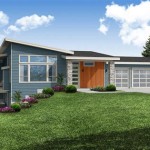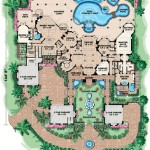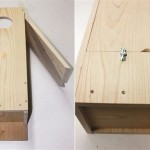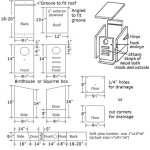One-bedroom house floor plans encompass the layout and organization of living spaces within a compact dwelling featuring a single dedicated bedroom. These plans are designed to maximize functionality and comfort in a space-efficient manner, catering to individuals, couples, or small families.
One popular application of one-bedroom house floor plans is the creation of cozy starter homes for first-time homeowners or those seeking a low-maintenance living solution. They can also serve as guest houses, vacation retreats, or rental units, offering a comfortable and self-contained living space.
In the following sections, we will explore the various considerations and design elements that contribute to effective one-bedroom house floor plans. We will delve into the arrangement of key spaces, such as the bedroom, bathroom, kitchen, and living areas, as well as the incorporation of storage solutions, natural light, and accessibility features.
Essential Considerations for One-Bedroom House Floor Plans:
- Functional layout
- Efficient space utilization
- Natural light optimization
- Adequate storage solutions
- Accessible design features
- Privacy and separation
- Outdoor living spaces
- Cost-effective construction
These factors collectively contribute to creating comfortable, livable, and aesthetically pleasing one-bedroom house floor plans.
Functional layout
A functional layout is crucial for optimizing the use of space and creating a comfortable living environment in one-bedroom house floor plans. This involves carefully arranging the key spaces within the home to ensure smooth flow, accessibility, and privacy. The following points elaborate on essential considerations for functional layout:
- Open floor plan: An open floor plan seamlessly integrates the living room, dining area, and kitchen, creating a spacious and airy feel. This layout promotes natural light flow and facilitates easy movement between these communal spaces.
- Defined zones: While open floor plans offer spaciousness, it’s essential to define different zones within the living area. This can be achieved through the strategic placement of furniture, rugs, or partitions to create distinct areas for relaxation, dining, and potentially a home office.
- Efficient kitchen design: The kitchen should be designed with functionality in mind, featuring a well-organized layout that maximizes storage and work surface. Consider incorporating a breakfast bar or island to create additional seating and storage options.
- Bedroom privacy: The bedroom should be positioned away from high-traffic areas to ensure privacy and tranquility. Consider placing the bedroom at the back of the house or on a separate floor to minimize noise and disturbance.
By carefully considering these factors, one can create a functional layout that enhances the overall livability and comfort of a one-bedroom house floor plan.
Efficient space utilization
Efficient space utilization is paramount in one-bedroom house floor plans to create a comfortable and functional living environment. Here are several key points to consider:
- Multi-purpose spaces: Designate areas that can serve multiple functions. For example, incorporate a built-in desk or shelves in the bedroom to create a dedicated workspace. Utilize ottomans with hidden storage to provide extra seating and storage options in the living room.
- Vertical storage: Make the most of vertical space by installing floating shelves, wall-mounted cabinets, and stackable storage bins. Utilize the height of the walls to store items that are not frequently used, freeing up floor space for essential belongings.
- Built-in furniture: Custom-built furniture can be tailored to fit specific spaces and needs. Consider incorporating built-in bookshelves, drawers, and seating to maximize storage and optimize the use of available floor area.
- Declutter and organize: Regularly declutter and organize belongings to maintain a sense of spaciousness. Utilize drawer dividers, under-bed storage containers, and other organizational tools to keep items tidy and accessible.
By implementing these space-saving strategies, one can create a one-bedroom house floor plan that feels both comfortable and efficient, maximizing functionality without compromising on style or livability.
Natural light optimization
Natural light plays a vital role in creating a warm, inviting, and energy-efficient living space. In one-bedroom house floor plans, optimizing natural light can be achieved through thoughtful design and strategic placement of windows and other openings.
- Maximize window size and placement: Incorporate large windows in the main living areas, bedroom, and kitchen to allow ample natural light to penetrate the space. Position windows strategically to capture sunlight at different times of the day, reducing the need for artificial lighting.
- Utilize skylights and solar tubes: Skylights and solar tubes are excellent options for bringing natural light into areas with limited window placement, such as bathrooms, hallways, and interior rooms. These features allow light to enter from above, creating a brighter and more spacious feel.
- Choose light-colored interiors: Light-colored walls, ceilings, and flooring reflect natural light more effectively, making the space feel brighter and larger. Avoid using dark or heavy colors, as they can absorb light and make the room appear smaller and dimmer.
- Minimize obstructions: Avoid placing furniture or bulky objects in front of windows, as they can block natural light from entering the room. Keep window treatments simple and sheer to allow maximum light transmission.
By implementing these natural light optimization techniques, one can create a one-bedroom house floor plan that is not only energy-efficient but also fosters a sense of well-being and comfort.
Adequate storage solutions
Adequate storage solutions are crucial in one-bedroom house floor plans to maintain a clutter-free and organized living space. Here are several key points to consider:
- Built-in storage: Utilize built-in storage options such as closets, cabinets, drawers, and shelves to maximize space utilization and create a seamless look. Built-in storage can be customized to fit specific needs and spaces, providing ample storage for clothing, linens, and other belongings.
- Vertical storage: Make the most of vertical space by installing floating shelves, wall-mounted cabinets, and stackable storage bins. Utilize the height of the walls to store items that are not frequently used, freeing up floor space for essential belongings.
- Multi-purpose furniture: Choose furniture pieces that offer dual functionality and storage capabilities. Ottomans with hidden storage compartments, beds with built-in drawers, and coffee tables with shelves provide additional storage options without taking up extra floor space.
- Underutilized spaces: Utilize often-overlooked spaces for storage, such as under the bed, above the closet, or in the eaves of the house. By incorporating storage solutions into these areas, you can maximize space utilization and keep clutter off the floor.
By implementing these adequate storage solutions, one can create a one-bedroom house floor plan that is both functional and aesthetically pleasing, providing ample space for belongings while maintaining a sense of order and spaciousness.
Accessible design features
Accessible design features are essential in one-bedroom house floor plans to ensure that the home is comfortable, safe, and accessible for individuals with disabilities or mobility impairments. By incorporating these features, one can create a livable and inclusive space that meets the needs of all occupants.
- Wide doorways and hallways: Ensure that doorways and hallways are wide enough to accommodate wheelchairs and other mobility aids, typically measuring around 32-36 inches in width. This allows for easy and safe movement throughout the home.
- Step-free entry: Eliminate steps and thresholds at entry points to provide seamless access for individuals using wheelchairs or walkers. Ramps or gradual slopes can be incorporated to ensure a smooth transition from the exterior to the interior of the home.
- Accessible bathroom: Design the bathroom with accessibility in mind, featuring a roll-in shower or bathtub with grab bars, a raised toilet seat, and adequate maneuvering space. Non-slip flooring and accessible fixtures can further enhance safety and comfort.
- Universal design elements: Incorporate universal design elements throughout the home, such as lever-handled door knobs, adjustable countertops, and voice-activated controls. These features make the home more user-friendly and accessible for individuals with a wide range of abilities.
By implementing these accessible design features, one can create a one-bedroom house floor plan that is not only stylish but also inclusive and welcoming to all.
Privacy and separation
Privacy and separation are important considerations in one-bedroom house floor plans, especially if multiple individuals will be occupying the space. Thoughtful design can create a sense of privacy and separation between the bedroom and other areas of the home, ensuring a comfortable and harmonious living environment.
Bedroom placement: The placement of the bedroom is crucial for ensuring privacy. Ideally, the bedroom should be situated away from high-traffic areas and noise sources, such as the living room or kitchen. If possible, position the bedroom at the back of the house or on a separate floor to minimize disturbance and create a more private retreat.
Soundproofing: Incorporating soundproofing measures can further enhance privacy and separation. Utilize sound-absorbing materials in walls and ceilings, such as insulation or acoustic panels, to reduce noise transmission between rooms. Additionally, consider installing double-glazed windows to minimize noise from outside sources.
Separate entrances: If the one-bedroom house is intended for multiple occupants, consider creating separate entrances for the bedroom and other areas of the home. This provides a sense of independence and privacy for each individual, allowing them to come and go without disturbing others.
Defined spaces: Within the bedroom itself, it’s important to define separate areas for sleeping, dressing, and working or studying. Utilize room dividers, screens, or curtains to create visual separation and establish distinct zones within the room. This can help maintain a sense of privacy and order, even in a compact space.
Outdoor living spaces
Incorporating outdoor living spaces into one-bedroom house floor plans can significantly enhance the functionality and enjoyment of the home. These spaces provide an extension of the living area, offering opportunities for relaxation, entertainment, and connection with nature.
Patios and decks: Patios and decks are popular outdoor living spaces that extend the living area outdoors. They provide a dedicated space for grilling, dining, or simply relaxing in the fresh air. Patios are typically constructed on a concrete or paver base, while decks are elevated platforms made of wood or composite materials. Both options can be customized with features such as built-in seating, shade structures, and outdoor lighting.
Balconies and porches: Balconies and porches offer outdoor living spaces that are typically attached to the house, providing a semi-enclosed area. Balconies are typically located on the upper floors of the house and offer views of the surrounding area. Porches, on the other hand, are covered outdoor spaces that are often found at the front or back of the house. They provide a sheltered area for relaxation and can be screened in to keep out insects.
Courtyards and gardens: Courtyards and gardens are fully enclosed outdoor spaces that offer privacy and a tranquil retreat. Courtyards are typically paved or landscaped areas that are surrounded by walls or fences. Gardens, on the other hand, are planted areas that can include a variety of plants, flowers, and even small ponds or water features.
By incorporating these outdoor living spaces into one-bedroom house floor plans, homeowners can create a more comfortable and enjoyable living environment that seamlessly blends indoor and outdoor living.
Cost-effective construction
Cost-effective construction is a crucial consideration when designing one-bedroom house floor plans. By implementing smart design strategies and selecting economical building materials, it’s possible to create a comfortable and stylish home without breaking the bank.
Smart design: Smart design involves optimizing the use of space and minimizing unnecessary features to reduce construction costs. This can include choosing a simple and efficient floor plan, avoiding complex rooflines, and opting for energy-efficient windows and appliances.
Economical materials: Selecting cost-effective building materials can significantly impact the overall construction cost. Consider using materials such as vinyl siding, laminate flooring, and composite shingles, which are durable, affordable, and require minimal maintenance.
Prefabricated components: Utilizing prefabricated components, such as wall panels and roof trusses, can save time and money during construction. These components are manufactured off-site and assembled on-site, reducing labor costs and minimizing construction waste.
Energy efficiency: Incorporating energy-efficient features into the design can reduce long-term utility costs and enhance the home’s overall value. Consider installing energy-efficient windows, insulation, and appliances to minimize energy consumption.
By implementing these cost-effective construction strategies, homeowners can create a one-bedroom house that meets their needs without sacrificing quality or style.










Related Posts








